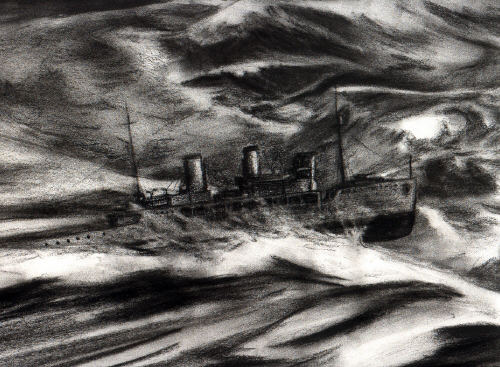

Detail from a fanciful sketch.
Late in the Summer of 1926, a hurricane wrought great damage on the colony of the Bahamas (a colony that had been founded by the Somers Isles, centuries before). As the naval headquarters for the Americas, the HM Dockyard at Ireland Island despatched a sloop -a minor vessel from its fleet- to render what aid it could (a duty which, today, would fall on the West Indies Guard Ship, a frigate that the navy rotates through deployments to protect British West Indian Waters, and that with the Dockyard long closed, only stops in the somers Isles on its way to and from its deployment).
The sloop sent to the Bahamas' aid was the HMS Valerian. An Arabis type of the Flower class built during the Great War, she was under the command of Commander W.A. Usher, with a complement of more than a hundred men. On the 18 October, 1926, having rendered what aid she could, she put to sea from Nassau to return to her base in the Somers Isles. Due to a shortage of coal in the Bahamas, she began the voyage with little more than what she needed to complete the 1,100 mile journey. This left her relatively light in the water with a detrimental effect on her stability.
A day after she began her voyage, the Valerian received reports from the US weather service that a tropical storm was forming to the South of Puerto Rico. This initially moved North and seemed no threat, but soon began curving to the North East to follow the Valerian home. Despite the late date, the storm quickly grew far more powerful than the weather forecasters had predicted. The Valerian, unaware of the true strength or speed of the storm still raced for home, not wanting to be caught at sea in so light a condition and lacking the coal to fight the weather for long if she were.
She very nearly made it. By 08:00 hrs on the morning of the 28 October she radioed the Dockyard that she was hove to eight miles from Gibbs Hill light, to the South West of the Colony. At that time, Cdr. Usher would report, there was no sign of the approach of a large storm, and he anticipated no difficulty making Timlin's Narrows -the channel, a handful of miles to the East, which provides the sole access through the isles' enclosing reefs. Inside the reefs, the vessel would be protected from the worsat the sea had to offer. This was the last message ever received from the Valerian. Only when the few survivors were plucked from the water the following day would the extent of its tragedy be known, but on that day the Dockyard establishment and the crews of its vessels, caught in and out of port, had all they could do to worry about themselves. The Valerian would be forgotten as the winds rose, by noon, to 125 mph as the storm drove in at the unprecedented speed of 700 miles a day. The army, who provided the civil forecast from their central camp , Prospect Camp, in Devonshire, took down thir anenometer (which measures windspeed,) at noon to prevent its being destroyed. At the Dockyard, the Navy was more concerned with saving its ships as the cruiser HMS Calcutta was ripped from its berth on the Southern Dock and swung bow to the wind. Multiplying the bow lines holding her to the dock, the crew leapt to the end of the North breakwater against which the stern had struck. Several lines were used to fasten it there, but the engines had still to be run full ahead to keep her from being driven back into the Sound, and to her destruction. The Dockyard's anenometer was destroyed at 13:00 as the winds reached 138 mph -- at about the same time the Valerian was finally succumbing to the wind and waves. At 10:00 hrs he following day, 19 men were picked from the water by the cruiser HMS Capetown, which had ridden the storm out safely at sea . The Capetown had actually begun a search for the Valerian the previous day, but had been called away by the SOS of the steamer the Eastway, which reported being in a desperate plight with her bunkers awash. She would also go to the bottom with loss of life.
The dead from the Valerian numbered 4 officers, and 84 men.
Commander Usher's account of the loss will be found below under Period News Articles.
Sloops
Articles